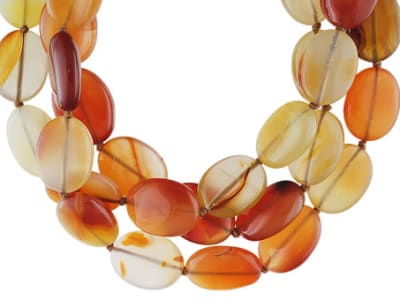Carnelian, which is sometimes also spelled as cornelian, is the orange to brownish red variety of chalcedony. It is often confused with sard which is reddish brown to brown in color. It is considered to be carnelian if the stones main color component is red or orange. It can also be confused with sardonyx which is reddish brown to brown and has white or cream banding. The stone gets its color from the presence of iron oxide. The material can be heated to increase color saturation. Stones might also be naturally or artificially iron stained as well. Several different sources for the name carnelian have been proposed from different Latin roots. Corum (cherry) and cornus (horn) are associated with the cornelian cherry tree that produces edible red fruit. The other source for the name comes from Latin words carnis (meat) or carne (flesh) due to its color. The oldest carnelian beads date back to the early Neolithic. The stone has been a popular choice for signet rings from Greek and Roman times until today.
General Information
LWUV: Inert
Carnelian Colors
-
 Orange
Orange -
 Red
Red
Alternate Names
Cornelian
Countries of Origin
Tanzania, United Republic Of; Russian Federation; Czechia; United States of America; Egypt; Madagascar; Thailand; United Kingdom of Great Britain and Northern Ireland; Portugal; Oman; Armenia; Greece; Austria; Mozambique; Unknown; China; Ireland; Luxembourg; Brazil; Poland; Slovakia; Bulgaria; France; Colombia; Romania; Hungary; Sri Lanka; Uruguay; Japan; Ukraine; United Arab Emirates; Switzerland; India; New Zealand; Canada; Botswana; Namibia; Italy; South Africa; Australia; Peru; Germany; Indonesia
History
The original carnelian mines were probably located in the Arabian Peninsula and India. Gem carving dates back to seventh millennium BCE. The earliest known carnelian beads have been found on a gold necklace in a gravesite in Bulgaria that dates to between 5300-4800 BCE. Beads that back to 4000 BCE have been found at Mehrgarh archeological site in modern day Pakistan. The carnelian for the Harappan beads are thought to have been mined from the area around Ratanpur village, Gujarat, India. The Southern Mesopotamian Royal Cemetery of Ur which dates to 2450 BCE contains etched carnelian beads that were decorated with grease or alkaline and then heated to produce whitish patterns or designs. Similarly decorated beads are found in archaeological sites throughout the middle east, China, and Russia. The stone was originally used for signet rings by the ancient Egyptians, Greeks, and Romans but it continues to be used for this purpose throughout history into modern day. In 1632 the Mughal Emperor Shah Jahan chose to decorate the Taj Mahal with carnelian because it was his favorite wife Queen Mumtaz favorite stone. In the 19th century carnelian was used widely in cameo carving. It was also a popular gemstone during the Art Deco period.
Care
Normal care
More About Carnelian
For as far back in time as we know, folklore has joined carnelian and good fortune. The Middle Eastern peoples considered carnelian a stone of kings and royalty. Due to its warm, rich orange-red color, they also associated it with fire. In Egypt, believers wore carnelian to ward off the evil eye and to bring peace to the wearer.

